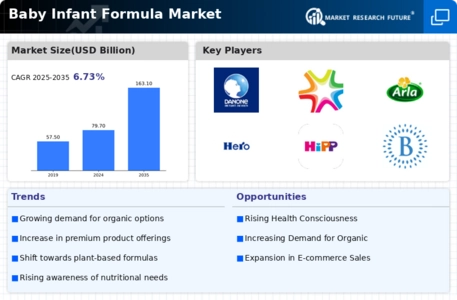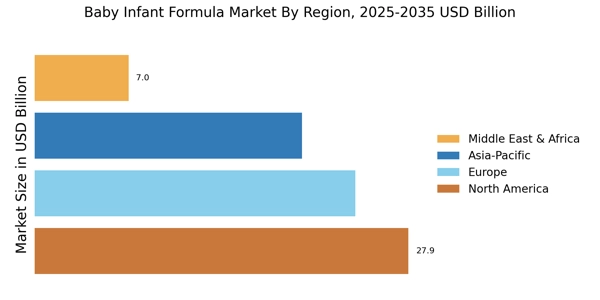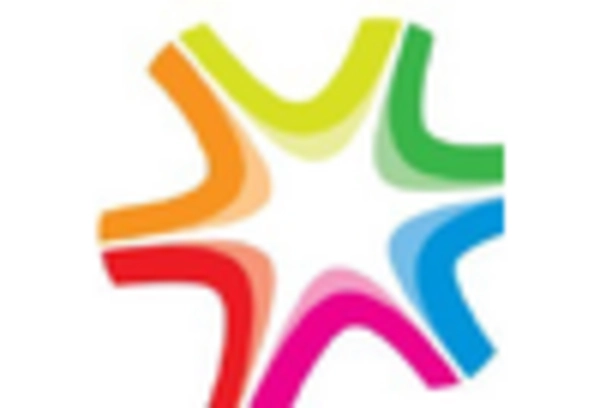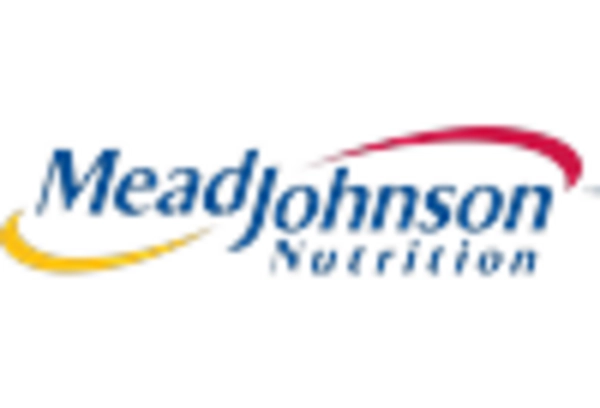Increasing Birth Rates
The Baby Infant Formula Market appears to be positively influenced by rising birth rates in various regions. As families expand, the demand for infant nutrition products escalates. Recent data indicates that certain regions have experienced a notable increase in birth rates, which correlates with heightened consumption of baby formula. This trend suggests that manufacturers may need to scale production to meet the growing needs of new parents. Additionally, the increasing awareness of infant nutrition among parents further propels the market forward, as they seek high-quality products for their children. Consequently, the Baby Infant Formula Market is likely to see sustained growth as more infants require nutritional support.
Rising Disposable Income
The Baby Infant Formula Market is significantly impacted by the rising disposable income of households. As families experience improved financial conditions, they tend to invest more in premium infant nutrition products. This trend is particularly evident in emerging economies, where an increase in disposable income has led to a shift towards higher-quality baby formulas. Market data suggests that parents are willing to spend more on organic and specialized formulas, which are perceived to offer better nutritional benefits. This willingness to invest in quality products indicates a potential for growth in the Baby Infant Formula Market, as parents prioritize their children's health and well-being.
Expansion of Distribution Channels
The Baby Infant Formula Market is witnessing an expansion of distribution channels, which is facilitating greater accessibility for consumers. The rise of e-commerce platforms has transformed the way parents purchase baby formula, allowing for convenient online shopping options. Additionally, traditional retail channels are also adapting to meet consumer demands by offering a wider variety of products. This diversification in distribution not only enhances consumer choice but also drives competition among manufacturers. As a result, the Baby Infant Formula Market is likely to experience increased sales and market penetration, as more parents gain access to a broader range of infant nutrition products.
Growing Awareness of Infant Nutrition
The Baby Infant Formula Market is experiencing a surge in demand due to the growing awareness of infant nutrition among parents. Educational campaigns and health initiatives have played a crucial role in informing parents about the importance of proper nutrition during infancy. As a result, there is an increasing preference for scientifically formulated baby formulas that cater to specific dietary needs. Market data reveals that parents are increasingly seeking products that are fortified with essential vitamins and minerals, which enhances the overall health of their infants. This heightened awareness is likely to drive innovation within the Baby Infant Formula Market, as manufacturers strive to meet the evolving expectations of health-conscious consumers.
Technological Advancements in Production
The Baby Infant Formula Market is benefiting from technological advancements in production processes. Innovations in manufacturing techniques have led to improved product quality and safety, which are paramount for infant nutrition. Enhanced processing methods allow for better preservation of nutrients, ensuring that formulas meet the highest standards of health. Furthermore, advancements in packaging technology contribute to longer shelf life and convenience for consumers. As these technologies continue to evolve, they may provide a competitive edge to manufacturers within the Baby Infant Formula Market, enabling them to cater to the increasing demand for high-quality infant nutrition products.


















Leave a Comment